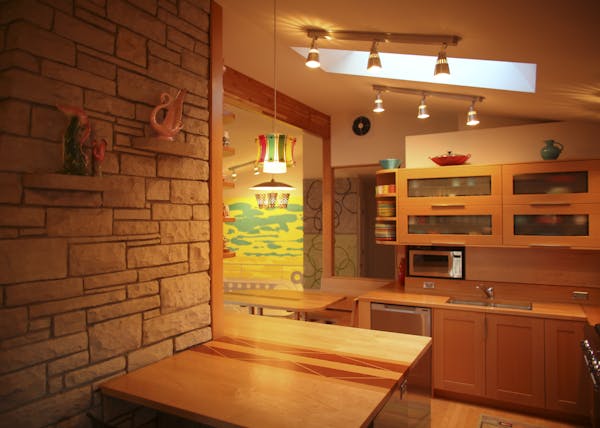Interior designer Laura Bischoff had always lived in 1920s-era houses — until she decided it would be fun to "dabble in a rambler."
Midcentury style was just beginning its renaissance, and simple, one-level living sounded appealing to Bischoff, owner of Metropolis Design Group (www.metropolisdesigngroup.net) and her husband, Tom Konz. "We're close to being empty-nesters," she said.
So the couple bought a 1952 rambler on a corner lot in south Minneapolis. The house, which had been used as an assisted-living residence, needed work, she said, but they made only a few cosmetic changes at first. "We lived here a couple of years to get to know it."
By the time they were ready to undertake a major makeover, Bischoff was clear on what she wanted to change (the closed-off kitchen) and what she was willing to keep (the pale peach ceramic-tiled bathroom).
"What drove me crazy was you came in the front door and the first thing you saw was the refrigerator," she said. "For entertaining, it was just not a pretty place." She consulted an architect, who suggested moving the front door to the other corner-facing side of the house.
That helped open up the floor plan and make the most of the home's 1,600 square feet. Bischoff also expanded one corner of the house 1 foot in both directions to create a dining area surrounded by a new corner window.
Cinematic inspiration
With the living and dining area both open to the new kitchen, Bischoff wanted to make sure it didn't detract from the ambience."How do we bridge a lovely living room with a very utilitarian kitchen?" she wondered.
She watched old movies for reference and inspiration, and was smitten with the "swank, awesome kitchens" she saw in "Yours, Mine and Ours," the 1968 film starring Henry Fonda and Lucille Ball, and "The Courtship of Eddie's Father," the 1963 film that inspired the TV series.
Instead of blond woodwork, popular during the 1950s and widely used in homes in her neighborhood, Bischoff opted for darker wood, alder with a walnut stain. "We wanted it to be able to go casual or dressy," she said.
Storage posed another challenge. "When we opened up the kitchen, we gave up some upper cabinets," she said. Her solution: a pot rack for overhead storage and a free-standing custom china cabinet in striped veneer.
Adding architecture
Custom cabinetry is a favorite design trick of Bischoff's, one that works especially well in 1950s ramblers.
"They don't bring a lot of architecture to the table," she said. "You don't have much to work with, but the upside is, it's easy to add architecture." Other custom built-ins in her house include a narrow, 11-inch bench along one window; it provides seating for guests, but doubles as storage under its lift-up seat. Her entry closet has a big built-in drawer at the bottom for storing shoes.
To update the look of her home, Bischoff added beefier door frames, window frames and baseboards. "Rambler molding tends to be small," she said.
She kept her original fireplace but reclad it in French limestone for a clean, contemporary look. Behind it, a fourth bedroom was converted into a family room/office with a wall of Ikea storage cabinets.
"We use every square inch of this house," Bischoff said.
Redoing her first rambler has made her a convert. "Living on one level is a nice thing for raising a family. It's easy to know what everybody's doing," she said.
And, from a design standpoint, the simple houses offer a great canvas for a wide variety of looks and updates. "I think ramblers are fun. You don't have to do much to get huge results," she said.
Kim Palmer • 612-673-4784

Minnesota Sports Hall of Fame: A class-by-class list of all members

This retired journalist changed professional wrestling from Mankato

